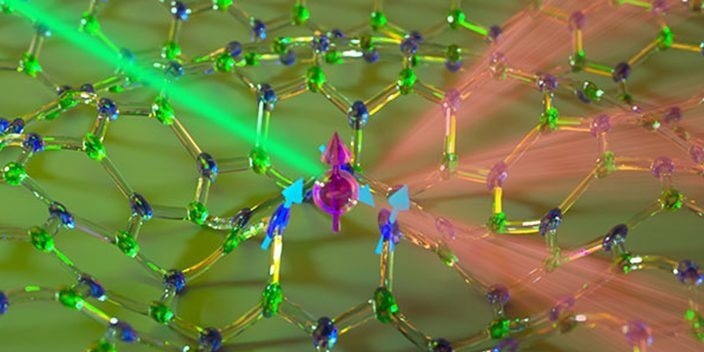Purdue University researchers have unlocked a new frontier in quantum science and technology by using photons and electron spin qubits to regulate nuclear spins in a two-dimensional material.
 Using photons and electron spin qubits, researchers demonstrated atomic-scale sensing for use in NMR, and by controlling nuclear spin, creating nuclear qubits with longer coherence times than previously used electron spin qubits. Image Credit: Purdue University.
Using photons and electron spin qubits, researchers demonstrated atomic-scale sensing for use in NMR, and by controlling nuclear spin, creating nuclear qubits with longer coherence times than previously used electron spin qubits. Image Credit: Purdue University.
This technique paves the way for applications such as atomic-scale nuclear magnetic resonance spectroscopy and the ability to read and write quantum information with nuclear spins in 2D materials.
The research team employed electron spin qubits as atomic-scale sensors to achieve the first experimental control of nuclear spin qubits in ultrathin hexagonal boron nitride, as it was reported on August 15th, 2022 in Nature Materials.
This is the first work showing optical initialization and coherent control of nuclear spins in 2D materials. Now we can use light to initialize nuclear spins and with that control, we can write and read quantum information with nuclear spins in 2D materials. This method can have many different applications in quantum memory, quantum sensing, and quantum simulation.
Tongcang Li, Study Corresponding Author and Associate Professor, Physics and Astronomy and Electrical and Computer Engineering, Purdue University
The qubit, the quantum equivalent of a conventional computer bit, is essential to quantum technology. Instead of a silicon transistor, it is frequently constructed using an atom, subatomic particle, or photon.
The familiar binary “0” or “1” state of a conventional computer bit is expressed by spin in an electron or nuclear spin qubit; this attribute is somewhat equivalent to magnetic polarity, meaning the spin is responsive to an electromagnetic field. The spin must first be coherent and under control, or durable to complete any task.
When utilized as a sensor, the spin qubit can measure a target’s temperature or the structure of a protein with nanoscale resolution. Imaging and sensing resolution in the 10–100 nm range has been achieved by electrons trapped in 3D diamond crystal defects.
But since they are incorporated in single-layer, or 2D, materials, qubits can be placed near a target sample and provide even better resolution and signal strength.
The first hexagonal boron nitride electron spin qubit, which can exist in a single layer, was constructed in 2019 by extracting a boron atom from the lattice of atoms and capturing an electron in its place, paving the road to that objective.
The possibility of influencing the nuclear spin of the nitrogen atoms around each electron spin qubit in the lattice was likewise tantalizingly presented by so-called boron vacancy electron spin qubits.
In this study, Li and his colleagues created a connection between photons and nuclear spins in very thin hexagonal boron nitrides.
The surrounding electron spin qubits can optically initiate the nuclear spins, setting them to a known spin. Once initialized, a radio frequency can “write” information by changing the nuclear spin qubit or “read” information by measuring changes in the nuclear spin qubits.
Their technique uses three nitrogen atoms at once and has coherence periods more than 30 times longer than those of electron qubits at ambient temperature. Additionally, a sensor can be incorporated into the 2D material by physically layering it on top of another material.
Li added, “A 2D nuclear spin lattice will be suitable for large-scale quantum simulation. It can work at higher temperatures than superconducting qubits.”
Researchers started by extracting a boron atom from the lattice and replaced it with an electron to control a nuclear spin qubit. Three nitrogen atoms surround the electron at this time. Each nitrogen nucleus is now in a random spin state, which can be either –1, 0, or +1.
Subsequently, using laser light, the electron is pumped to a spin-state of 0, which has little impact on the spin of the nitrogen nucleus.
Finally, a spin shift in the nitrogen nucleus is brought about by a hyperfine interaction between the excited electron and the three neighboring nitrogen nuclei. The nucleus’s spin reaches the +1 state after several iterations of the cycle, where it stays independent of additional interactions. They can be utilized as a trio of qubits when all three nuclei are in the +1 state.
At Purdue, Li worked with Kejun Li and Yuan Ping from the University of California, Santa Cruz, as well as Takashi Taniguchi and Kenji Watanabe from the National Institute for Materials Science in Japan.
He also collaborated with Xingyu Gao, Sumukh Vaidya, Peng Ju, Boyang Jiang, Zhujing Xu, Andres E. Llacsahuanga Allcca, Kunhong Shen, Sunil A. Bhave, and Yong P. Chen.
The Purdue Quantum Science and Engineering Institute, DARPA, National Science Foundation, U.S. Department of Energy, Office of Naval Research, Tohoku AIMR and FriDUO program, and JSPS KAKENHI provided funding for the study’s publication.
Journal Reference:
Gao, X., et al. (2022) Nuclear spin polarization and control in hexagonal boron nitride. Nature Materials. doi:10.1038/s41563-022-01329-8.